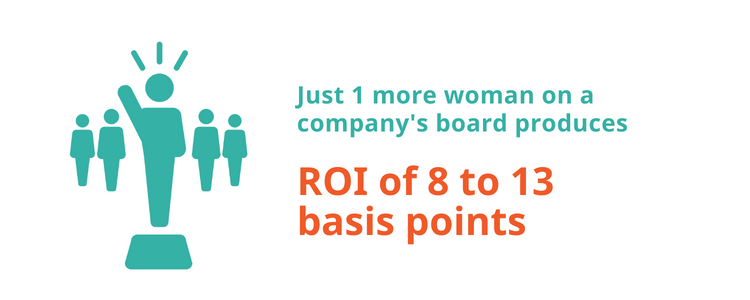Researchers find that having women on boards is making an impact. Companies with more women on their board improve cohesiveness and decision-making, increase corporate social responsibility, and respond better to change. Gender-balanced boardrooms are almost 20% more likely to improve business outcomes. They also have a greater ability to gauge consumer interest and demand. And companies that add just one more woman to their board (while keeping the board size unchanged) achieve an ROI of 8 to 13 basis points.


Yet Deloitte reports that globally only 19.7% of board seats are held by women. Likewise, just 6.7% of boards have female chairs. As a result, increasing social pressure has prompted top asset management companies to set guidelines to encourage diversity in U.S. boardrooms and abroad.
Goldman Sachs expects large portfolio companies to have at least one director from an under-represented group (with an emphasis on women). Along with this, BlackRock requiring boardrooms that are 30% diverse. Lastly, State Street expects most developed countries to have women in at least 30% of directorships by the end of 2023.
Goldman Sachs won’t take a company public if diversity isn’t prioritized. BlackRock cites a lack of diversity as a reason more directors were voted against in 2021 than in prior years. And State Street is prepared to cast proxy votes against board leaders if companies don’t meet diversity expectations.



Demand for Women on Boards Impacts Legislation
Africa, Europe, and North America have the highest percentages of women on boards. Africa comes in at the top at 30.5%. The Middle East/North Africa, Latin/South America, and Asia have the lowest rates, with the Middle East dragging behind at 10.2%.
Europe
In 2003, Norway was the first country to institute a quota for women on boards. Since then, other countries have followed. These include France, Germany, Belgium, Italy, Spain, Kenya, Iceland, and the UK.
- France’s Parliament passed a new law requiring companies with more than a thousand employees to have 30% of either gender on their executive teams and leadership pipelines by 2027, which will increase to 40% by 2030. They currently have the highest percentage of female board members at 43.2%.
- The UK determined women should make up at least 40% of boards at the top 350 British companies by late 2025 and is currently at 30.1%. The Financial Conduct Authority (FCA) requires annual statements confirming compliance to increase transparency.
- Based on the European Women on Boards Gender Diversity Index (2021), legislation that went into effect in Italy in 2012 has increased the number of female board members at Italian companies from 7% in 2011 to 37% in 2021.
- In 2020, the European Commission announced the Gender Equality Strategy 2020-2025, which is designed to reach a gender balance of 50% in its management structure by 2025.
- In July 2022, draft legislation for the Women on Boards Directive was agreed upon by European Parliament and the European Union to boost the presence of women on corporate boards of publicly listed companies. By June 2026, corporations must adjust their recruitment procedures to allow for women in 33% of all director posts or 40% of non-executive director posts.
The U.S.
According to Spencer Stuart, 32% of all S&P 500 directors in the U.S. were women in 2022. This was up from 30% in 2021 and 17% in 2012.
Nasdaq’s Board Diversity Rule was approved by the SEC in 2021 and required most companies listed in the U.S. stock exchange to disclose annual board-level diversity statistics starting in August 2022. Boards had to have at least one female, minority, or LGBTQ+ director by 2023, or explain why. The requirement increases to at least two diverse directors (based on categories defined by the EEOC) by 2025-2026.
The United States has no federal laws regarding the number of women required on corporate boards. Regardless, several states have introduced mandates to encourage companies to diversify, with several more having legislation pending.
This women leaders infographic takes a look at stalls, setbacks, and slow progress for women leaders in the U.S. over the past 60+ years.
Benefits of a Gender-Balanced Boardroom
Comprehensive research indicates that corporations with more women in board seats have greater success overall. Historically, most boardrooms have been filled by men. Companies that prioritize gender diversity reap the benefits of opening their leadership pipelines. Those that don’t fully leverage the pool of human capital decrease their competitive advantage.
Reduced “Group Think”
Generally speaking, women tend to conform less and have more diverse viewpoints. This is most likely due to the fact that they don’t belong to “old-boy networks.” They seek out different opinions to challenge the status quo. Therefore, discussions are broadened to include the views of a variety of stakeholders. This means controversial issues are discussed more effectively, innovation is increased in problem-solving, and companies are more adaptable to change.
This inclusivity leads to improved corporate responsibility and higher returns. As a result, companies are better able to relate to and connect with customers, employees, investors, and local communities.
Just the Facts
Since women have a higher interest in inclusivity, they’ve learned to be persuasive. They achieve this by using more facts and fewer observations. Likewise, they’re more likely to speak truth to power and challenge dominant opinions with logic. Potentially biased beliefs held by overconfident CEOs are challenged. This results in less aggressive risk-taking and improved investment decisions.
Engaged Employees
Studies have shown that women have better attendance records and spend more time preparing for board meetings. This in turn has made their male counterparts step up their games to keep up. And the IBM Institute for Business Value (IBV) found job satisfaction rates are higher for men who work at companies with more female executives.
How To Boost Female Representation on Your Board
Expand Your Search
Extend your board search beyond the typical current/former CEO talent pool, which is typically male. Make your objectives known up front. Require search firms to seek out and identify qualified female candidates in addition to male candidates.
Hire More Female CEOs
The 2020 When Women Lead Report released by 50/50 Women on Boards indicates that companies led by women have greater gender diversity on their boards of directors. Out of the 150+ gender-balanced boards studied, 32% have women as CEOs. In addition, 20% have women as board chairs. And lastly, 9% have both a woman CEO and board chair. In fact, Deloitte reported a “multiplier effect,” as every woman hired for the C-suite at financial services firms resulted in a 300% increase in women in senior leadership roles at these companies.
Commit to Gender Diversity
Declaring that your company values diversity and inclusion is a great first step. However, public scrutiny requires concrete actions. Use IMPACT Group’s Gender Diversity Assessment Workbook to gain insight regarding your overall workforce, hiring practices, and development needs to recognize opportunities to increase gender diversity and create a strategic plan.



Develop High-Potential Women
Developing your female leaders will ensure a diverse talent pool when it’s time to promote from within. IMPACT Group’s Women in Leadership™ coaching program fast-tracks the development and advancement of women. This is achieved through self-assessment, goal setting, coaching, and learning activities. This isn’t a program designed to make women more like men while also leaving out the employee’s manager. IMPACT Group takes a different approach.
Our three-part career accelerator model guides women to enhance their personal effectiveness, business acumen, and corporate visibility. We achieve this by using one-on-one coaching and custom development plans to assess their skills more realistically. The program includes high-potential women and their bosses, who are usually male. This not only provides insight and helps women see executive sponsorship in action—it also encourages male managers to take a more active role in developing current and future female leaders.
There’s no doubt women in leadership roles make a difference, as the advantages of a gender-diverse boardroom can be found at all organizational levels. With such a tight job market, can your company afford to ignore half of the talent pool? View our Women in Leadership Checklist to learn how to attract and retain high-potential leaders and close the gender gap.









